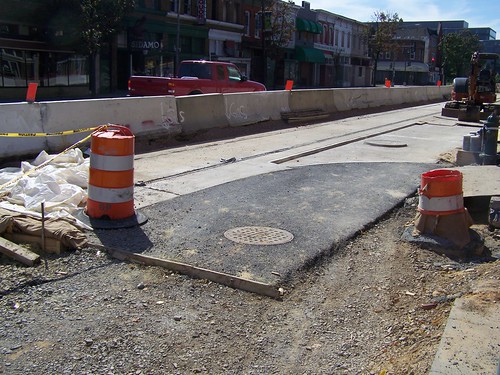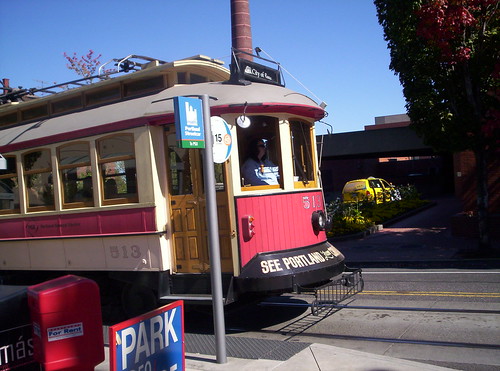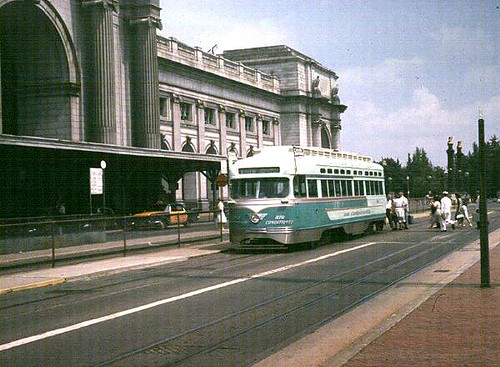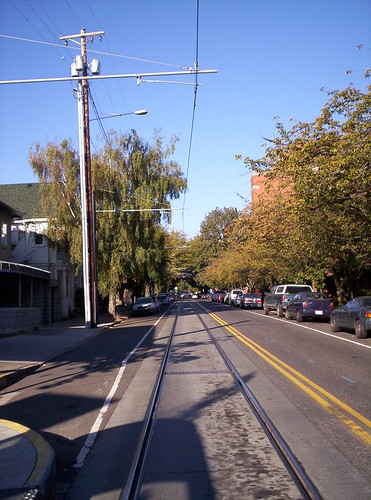The Dave's Railpix website is a good source for historical photos of streetcars and trolleys.
Greater Greater Washington has a magisterial post ("The DC Streetcar starts service on Saturday. It took a wild ride to get here") on the events that have transpired from the beginning of streetcar planning to the opening of the streetcar this weekend ("DC Streetcar Will Start Passenger Service on February 27" Washingtonian) to passenger service.
When it was first proposed, as part of a planning process called the DC Alternatives Analysis in 2003, I was strongly favorable. But since then the project hasn't been particularly smooth.
What should the city's transit priority be: streetcars or Metrorail expansion? And over time I came to believe despite the fact that streetcars are a superior mode compared to buses--better, smoother ride and will carry more people--and will attract more choice riders compared to buses, it would be better for DC to focus on expansion of Metrorail service within the city, specifically what was once called the separated blue line.
Streetcar service was conceived by top officials at the time as a way to extend better transit service because they had no hope that Metrorail would ever be extended within the city.
Failures in execution threaten the entire streetcar enterprise. But despite the focus on streetcars over Metrorail expansion, the process has been marked by problems.
First Hill Seattle Streetcar shelter, map inset, and map of station stops.
My joke is that DC and Seattle started planning for streetcars the same year, 2003, and Seattle opened its first streetcar line in 2007.
Seattle's second line opened a couple weeks ago and would have opened earlier except for delays on the part of the manufacturer.

Over the years, thinking more granularly about what DC's transit priorities should be, and the many failures in planning, design, engineering, and construction to build it, not to mention the financing and priorities of the city's elected officials which have waxed and waned, I am not nearly as supportive now.
-- "A crisis in confidence and the capacity of local government to execute transit projects," December 2014
At times I wonder if it is even worth pursuing streetcars given the animus that arises. Until you propose streetcars, it's hard to understand the strength of the privileging of the personally-owned automobile in our land use and transportation planning paradigm and the lengths that supporters will go to keep it that way.
The failures in DC had fallout locally too. Eventually, with a change in political leadership in Arlington County, the plan for streetcars there couldn't withstand the continued drumbeat of opposition, and couched in cost--not automobility--the program was cancelled.
Note too that failures in execution of the streetcar in DC are used by opponents in other communities to justify scuttling streetcar programs there.
It's a reverse example of "world class cities" and best practice. "Worst practice" has negative consequences too, because it doesn't go unnoticed, especially by the anti-transit and pro-automobility crowd.
The arguments by opponents. Streetcars are dated technology. Interestingly, a lot of the opposition trots the line that "streetcars are dated technology--from the 19th century," failing to acknowledge that cars too date to the 19th century, and both streetcars and motor vehicles have been significantly improved since.
Personal vs. mass transportation. The reality is that opposition to streetcars is not about "old technology," but about a preference for personal transportation--the car, and riding by yourself, versus mass transit and riding with others.
Only good for tourists. The other grouping of arguments calls streetcars not useful and more of a toy or attraction best to serve tourists. The entry "Frankly MARTA, I don’t Give a Tram," from the Trip Planner blog argues that streetcars only work as tourist attractions. I disagree. Tell that to Toronto, Philadelphia, or Melbourne, among others.
 Even though San Francisco's heritage streetcar line is seen as serving tourists primarily between Fisherman's Wharf and the Ferry Building, it simultaneously serves as a key element of the city's everyday transit network serving Downtown and Market Street.
Even though San Francisco's heritage streetcar line is seen as serving tourists primarily between Fisherman's Wharf and the Ferry Building, it simultaneously serves as a key element of the city's everyday transit network serving Downtown and Market Street.Nevertheless, the H Street streetcar is already a big success, economically. From the standpoint of spurring new development, the streetcar is already an incredible financial success having triggered close to $800 million in new construction (finished or underway) on the H Street NE corridor in the past couple years
-- "DC and streetcars #4: from the standpoint of stoking real estate development, the line is incredibly successful and it isn't even in service yet, and now that development is extending eastward past 15th Street," December 2015
including multiple projects east of 15th Street, an area not otherwise likely to experience development for decades to come.
Although in terms of transit related development, H Street possesses certain locational advantages and pre-conditions that are easily leverageable where other locations are not so easily able to spur development along:
-- "If you build it (streetcars) does economic development magically happen?," July 2008 (about Anacostia).
-- "Purple line planning in suburban Maryland as an opportunity to integrate place and people focused initiatives into delivery of new transit systems," March 2014
On the pending launch for passenger service, it's worth revisiting some of my past posts on streetcars and DC.
1. I have written scads of entries about H Street and urban revitalization--it's where I made my bones--but we can't discuss the pending launch of passenger service for the streetcar without acknowledging Joe Fengler.
Despite all those who take credit for the streetcar and will during speech time at the launch, without Joe the streetcar wouldn't be opening for business this Saturday.
During the time when the H Street Streetscape and Transportation Study planning process was underway (2003-2004), Joe Fengler, then chair of Advisory Neighborhood Commission 6A, realized that it would be more efficient to install streetcar tracks when the streetscape was being reconstructed, rather than tearing it up again for rails.
But at the same time that he used the "efficiency argument" he had a hidden agenda--recognizing that with rails in the street H Street would be much more likely to get streetcar service--especially if obstacles arose in Ward 8, where streetcar service was once expected to launch as early as 2007 (as proclaimed so confidently by a DDOT employee at the Regional Bus Conference in Fall 2006).

Construction of the railtrack bed on the 500 block of H Street NE.
Joe organized a campaign to get DDOT to install the tracks and reconstruct the streetscape simultaneously, getting other ANCs in the H Street-Benning Road corridor to sign on in support, and eventually DDOT made the commitment.
Too bad they didn't start planning for the electricity infrastructure and access to Union Station at the same time, which ended up delaying the project for at least two years, and resulted in the failure to connect the streetcar more directly to Union Station.
-- "Capturing best practices/the process and promise of urban revitalization (in strong markets)," October 2011
-- "The community development approach and the revitalization of DC's H Street corridor: congruent or oppositional approaches?," March 2013
-- "360 Apartment building + Giant Supermarket vs. a BP gas station, which would you choose?," May 2013
2. This 2006 post suggested that like the Market Street Railway in San Francisco, DC could integrate heritage streetcars into the service mix, perhaps in conjunction with the National Capital Trolley Museum.
 I was inspired in part by seeing a heritage streetcar running in Portland--it used to run on the light rail tracks and this helped draw publicity to the creation of the original modern streetcar line in Portland, which connected Downtown and Portland State University to the new Pearl District and the venerable Nob Hill neighborhood.
I was inspired in part by seeing a heritage streetcar running in Portland--it used to run on the light rail tracks and this helped draw publicity to the creation of the original modern streetcar line in Portland, which connected Downtown and Portland State University to the new Pearl District and the venerable Nob Hill neighborhood. Lee Rogers, now deceased, a longtime streetcar advocate and historian, also spurred the idea.
-- "Adding cultural heritage dimensions and expanded service capabilities within commercial districts to DC Streetcar planning" January 2006
3. In response to many articles about streetcars that failed to adequately distinguish between types of transit and what streetcars are good at, I wrote this piece, distinguishing between inter-city and intra-city transit, not just about streetcars but about circulators and other forms. It built on earlier writings about how to think about transit networks and what I call the "transit shed" of transit networks and "mobility sheds" centered on transit stations.
-- "Making the case for intra-city (vs. inter-city) transit planning," October 2011
4. In response to articles either criticizing streetcars for being more about economic development, or in favor of it for the same reason but therefore accepting it as a substandard form of transit, I wrote a couple pieces further distinguishing the point of difference between inter-city transit and intra-city transit.
The H Street streetcar line addresses intra-district transit west from H Street eventually to Georgetown and Rosslyn and eastward into Ward 7, and in fact, the old 10/12 line traveled this route, between Deanwood and Rosslyn.
-- "STREETCARS ARE ABOUT TRANSIT, just in a different way from how most people are accustomed to thinking about it," January 2014
-- "The argument that streetcars are "good enough" but "imperfect transit" is flawed," October 2014 (sadly this was in response to a piece by GGW among others)
-- "DC and streetcars #3: More discussion (from almost 2 years ago)," December 2015
5. This piece suggests focusing on a crosstown route, because of the problems getting Congress to sign off on allowing wires. Building on the original line proposed between the Woodley Park and Brookland Metrorail stations, it proposed an extended line, with legs serving AU and Georgetown Universities on the west and service beyond Brookland to the University of Maryland in College Park.
-- "Will streetcars really return to the Capital City?," April 2009
6. These are a few of the entries discussing problems with city's planning and implementation of the streetcar.
-- "Streetcar and capital planning in the Washington metropolitan area," September 2010
-- "Looking backwards vs. looking forwards, tradeoffs, constraints and urban revitalization in the 21st century city," April 2010
-- "Blaming the mode: faulting DC's streetcar because of massive failures by DC Government in planning and execution," March 2015
 7. A couple years ago I suggested creating a separate heritage streetcar system combined with integrated visitor services to provide tourist-focused transportation functions around the National Mall.
7. A couple years ago I suggested creating a separate heritage streetcar system combined with integrated visitor services to provide tourist-focused transportation functions around the National Mall. It's modeled after the F Line/Market Street Railway service in San Francisco.
The original piece proposed a system with major nodes at Union Station and Jefferson Memorial, integrated with a new Yellow Line station at the Jefferson Memorial, visitor centers at Union Station and Jefferson Memorial, and even visitor parking under the National Mall.

PCC Streetcar painted in the livery of the DC Transit streetcar system in front of the Ferry Building in San Francisco. Flickr photo by Greg Goodman.

Silver Sightseer streetcar, Union Station.
Later I realized that this system should be extended further west with connections to Georgetown and across the Potomac River to Arlington Cemetery. Like many people, I missed the importance of visitor transportation needs being both from west to east, not just east to west, and focused on serving the visitor with an integrated system, seamlessly across jurisdictions.
-- "A National Mall-focused heritage (replica) streetcar service to serve visitors is a way bigger idea than a parking garage under the Mall," August 2013
-- "New DC Circulator route serving National Mall reminds us that we are neglecting connections from west to east and fail to adequately connect Georgetown to the National Mall," June 2015
The National Park Service manages the "National Mall" as a unit spanning the Potomac River, primarily located in DC but also including sections of Arlington County, Virginia. Transit delivered by each jurisdiction fails to serve the National Mall as an integrated unit. And special tourist-focused transit services are very expensive and don't serve local audiences.

8. Joe Fengler was right! What I thought of as spurious opposition to the streetcar on the part of residents in Anacostia has delayed implementation there by many many years, so the streetcars the city has have been diverted to H Street, which has tracks in the ground.
Similarly, a church downtown has expressed opposition to streetcar service passing their church, as a kind of abomination.
-- "Whither Light rail in Anacostia?," May 2005
-- "When seeing isn't believing, how do you correct for vision impairment?," November 2005 (this entry discusses my shock that people went on a site visit to Portland and then came back and argued that DC streets in Anacostia couldn't accommodate a streetcar)
-- "Streetcars, street widths, and Anacostia," July 2006
-- "The co-existence of streetcars and churches elsewhere," December 2014

Streetcar route in the Nob Hill neighborhood of Portland. I think this is NW Northrup Street. The roadway is narrow enough to demonstrate that streetcars can be accommodate on most DC streets.
9. Another argument that opponents make is that rather than spend the money on streetcars, it's cheaper to upgrade bus services. The argument for streetcars over buses is threefold:
(1) higher quality service;
(2) more capacity; and
(3) will result in increased ridership from "choice riders" switching from cars.
The unanswered question is whether or not it is in fact possible to attract a much greater ridership of buses from focused improvements. At a 30% to 40% increase that would mean 4,000 to 5,200 new daily riders.
I don't think it would happen, the research is pretty clear about the economic stratification of mode choice when multiple modes are available, but I think it's worth testing the implementation of a high quality regular bus service, modeled on the kinds of improvements implemented as part of true Bus Rapid Transit service.
-- "The need for a double decker bus vs. streetcar comparison study," January 2014
-- "Making bus service sexy and more equitable," September 2012



Richard, FYI, this post is having problems loading on my iPhone. Keeps blinking.
ReplyDeleteMost of the pictures you have show streetcars with about the same capacity as a bus. I thought the ones in Toronto were bigger.
This is the larger point is that streetcars can be more cost effective by reducing the labor costs, increasing the capacity, and providing quicker loading.
(And again in DC the lack of a payment system plan is part of the problem. And no, proof of payment isn't going to work well here. )
I think, but don't know for sure, that people are willing to withstand greater passenger densities on streetcars.
ReplyDelete2. Yes, the value of streetcars comes in reducing labor costs. But I expect that is more likely to come from running streetcars in pairs.
However, I don't think (I haven't checked) that is legal to do this in the US. I suppose this because it isn't legal to run buses longer than the approx. 60 foot long articulated buses on streets shared with other motor vehicles. (One of the reasons BRT works in South America is because they can use the bigger buses. More capacity for the same amount of labor.)
Toronto is moving to a 91 foot long car with 70 seats and room for 180 to stand.
https://farm4.staticflickr.com/3316/4595240993_a67a3e0e84.jpg"
3. Absolutely, proof of payment will not work here. It wouldn't matter so much if we had a large base of pass usage. We don't.
4. Basically, streetcars won't be all that useful because you need many to have the kind of frequency that is required, at least if the line were significant e.g., from Minnesota and Benning Road stations to Rosslyn.
Years ago I talked to a prof. at Gallaudet, who said his father went to school in the 1940s when the streetcars operated, and the father said frequency was so significant that he could get from H St. to Rosslyn in 15 minutes.
Even if we had frequencies of 6-8 minutes we'd need a lot more cars.
RE: Density, yeah, I suppose I'd be happier about standing on a streetcar than on a bus. Ride quality better, still have to deal with braking.
ReplyDeleteDidn't know about the 60 foot thing, that is clearly a problem then.
With dwell times, I doubt you can do 15 minutes today on orange line from Cap South to Rosslyn, which is the same E-W distance -- although a few more stop thank to the N-S jog.
proof of payment can be SO annoying. like i ride the LA transit system daily and today on one round trip I had my transit card checked 3 times. other times they go weeks without checking, which i guess is intentional.
ReplyDeleteit has only happened once or twice, but when I miss a connecting train bc there is a line at the officers checking cards i get pissed off!
still way better out here, much more affordable transit and massive expansion going on
I should add that perhaps proof of payment is better than the situation on buses, in which somehow a bus driver is supposed to monitor all passengers, drive and ensure that all passengers pay (really an impossible task).
ReplyDeletereally i'd prefer for transit to be free but that won't be happening anytime soon.
whoa, have you left DC?
ReplyDeletewrt proof of payment, the only place I really experienced it was Baltimore light rail. There, the checkers walk through the cars while they are in motion, not unlike how a MARC conductor collects tickets on passenger rail.
I haven't seen check out stations like you describe.
Proof of payment will work just fine.
ReplyDeleteThe assertions that "it won't work here" are weak, not-invented-here crap. It works just fine everywhere else in the world it's used - applications ranging from light rail to streetcars to NY's Select Bus Service.
But it won't work here? Sorry, you're gonna need to show some actual evidence to support that argument.
won't work here defined as lots of fare evasion.
ReplyDeleteLike the one rat says in the cartoon "Secret of NIMH": "take what you can when you can" is the story neighborhoods such as H St.
http://articles.latimes.com/2014/jan/29/local/la-me-fare-evasion-20140130
http://www.transitwiki.org/TransitWiki/images/8/8c/FareEvasionOnMuni.pdf
http://archives.sfexaminer.com/sanfrancisco/muni-fare-evasion-ticket-highlights-contrast-between-transit-agency-and-police-patrols/Content?oid=2752992
https://www.researchgate.net/publication/265642287_Fare_evasion_in_proof-of-payment_transit_systems_Deriving_the_optimum_inspection_level
wrt the loading issue, I think it has to do with one of the flickr scripts for the streetcar graphic. It seems to be working now, but who knows?
ReplyDelete"won't work here defined as lots of fare evasion."
ReplyDeleteWell, I don't think that's a very useful definition! There's plenty of fare evasion on Metro and the NYC Subway, too - despite their faregates. But they 'work' just fine.
I see lots of complaints about proof of payment that don't actually rise above FUD: Fear, Uncertainty, Doubt.
As for the specific cases in your articles:
LA: it's not that high of a rate of fare evasion, but a lack of fare compliance. Even if you have a valid pass, you must tap your card. Lots of people skip that step, but they've still paid.
SF: a guy paid, but still got a ticket. That's a technology issue that can be easily corrected.
For a better look at what's happening in SF, check their move to all-door boarding across the entire Muni system:
http://www.citylab.com/commute/2015/03/why-buses-should-let-you-board-through-any-door-in-2-charts/387739/
Dwell times decreased, buses sped up, and fare evasion actually went down. But, it can't 'work' there? Or here? Nonsense.